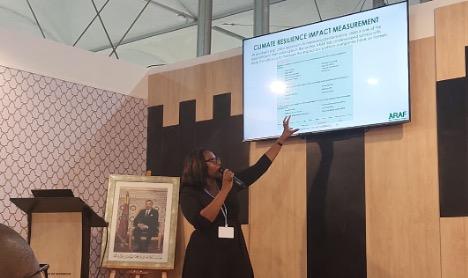 Kelvin Trautman
Kelvin Trautman

New coalition backs science-based investment targets for climate-smart agriculture
Metrics that measure climate adaptation can attract private sector investment to support climate-smart agriculture in Africa.
So CGIAR is supporting a coalition of partners with evidence and analytics to unlock capital that can transform land, water and food systems.
Adaptation is increasingly featuring in international climate discussions and being more heavily considered as an investment target.
Adaptation metrics are key to measure the success or failure of adaptation interventions, and therefore understand what tools, practices, and approaches are working towards enhancing farmers adaptive capacity and resilience to climate changes.
Tess Russo of the Bill and Melinda Gates Foundation noted that adaptation metrics are ‘essential’ to track progress toward targets concerning ‘smallholder farmer impact, income, productivity, women empowerment and nutrition’.
The development of such metrics will be no small task then….
The role of metrics in climate adaptation
Combining resources and intelligence to develop such metrics will be imperative.
The natural synergies of the Climate Shot Investor Coalition (CLIC), an action-oriented group for leaders in the impact investment community working in agriculture and food systems, and the CGIAR which aims to deliver locally derived evidence and analytics to unlock capital to transform the food land and water systems, seems well placed to navigate this challenge.
CGIAR is co-leading a CLIC action group focused on evidence-based tools, which seeks to enable the impact investing community to improve risk assessment and impact measurement in agriculture and food systems.
The two organisations teamed up with the International Platform of Adaptation Metrics (IPAM), together playing a key role in evaluating the needs of sectors, stakeholders, and purposes in relation to adaptation metric.
Together, they hosted a high-level side event at COP27 with key stakeholders from the public and private sectors. The objective was to discuss how adaptation metrics can address ongoing challenges in the commitment of private sector funds towards adaptation efforts.
COP27 stepped up the focus on adaptation for climate change ensuring it came out the shadow cast by mitigation, a concept much more easily measured and understood.
For instance, the Sharm-El-Sheikh Adaptation Agenda was launched as a comprehensive, shared agenda to rally global action around 30 adaptation outcomes that are needed to address the adaptation gap.
Though high-level attention towards adaptation is just emerging, several organisations have over the past decade set up initiatives focused on adaptation metrics. They have released research papers assessing the subject, initiated projects targeting specific adaptation financing with measurable outcomes, or are working towards global frameworks that are central to current efforts, and ways forward in tracking and assessing adaptation progress at a global level.

However, bottlenecks remain in addressing private sector finance commitments to adaptation in agriculture and food systems. Some of the challenges discussed at the side event included:
- The high costs in obtaining the necessary data for adaptation and resilience measurement.
- Monitoring and reporting of adaptation efforts due to a lack of accessible and common definitions or standards for adaptation metrics.
- Little harmonization of the adaptation and resilience indicators used between public and private sectors.
The side event participants agreed that improved adaptation metrics would help to demonstrate the impact of funds and enable private sector actors to understand, how, or if their financing is having the impact intended. Panellists identified the need to:
- Situate specific adaptation interventions within broader country objectives, considering the cross-cutting nature of risks and synergies between other climate related activities being implemented.
- Adaptation metrics need to be anchored in the reality of the local contexts that are to be monitored and evaluated to support decision making.
- Adaptation and resilience (A&R) metrics frameworks need to continuously adapt and improve based on concrete lessons learnt and feedback received from smallholder farmers, agri-companies, and investment or project implementers.
- Capacity building for such measurement activities should be provided to private and public sector organisations for further understanding on the best way to gather and define such information.


Rebecca Mincy from Acumen presented the Acumen Resilient Agriculture Fund, the world’s first equity fund designed to build the climate resilience of smallholder farmers.
Acumen collaborates with 60 Decibels to understand the local farmer contexts of their investees and measure the performance of their investments via tailored surveys considering farmers’ ability to adapt.
Through this they can incorporate lessons learnt to continually improve the investment process.
The CGIAR Hub for Sustainable Finance is developing science-based tools for risk assessment and impact quantification to assist investors in gathering adaptation and resilience (A&R) baseline data, enable ongoing monitoring and evaluating against A&R indicators, and ensure compliance with global regulations.
This is being implemented with—among others—the ‘Accelerating Impacts of CGIAR Climate Research for Africa (AICCRA)’ project and the African Enterprise Challenge Fund (AECF) to support cost-effective implementation of climate-smart agriculture, by instituting a science-based pipeline screening tool.
Similarly with asset managers responsAbility AG, CGIAR co-designed the first science-based fund on Climate Smart Food Systems, and will provide Technical Assistance pre and post investment to maximize the fund’s impact.
So, IPAM, the CGIAR and CLIC are taking the lead in developing targeted A&R metrics frameworks, assessment tools and solutions and will utilise the Climate Shot Investor Coalition member base, which brings together a diverse set of both public and private organisations, to test and pilot these solutions.
There should be much more to come and expect from this exciting topic.
Authors
- Bethany Cosgrove, CGIAR Hub for Sustainable Finance
- Godefroy Grosjean, CGIAR Hub for Sustainable Finance
- Richard Newman, CGIAR Hub for Sustainable Finance
- Andreea Nowak, Research Team Leader - Climate Action, Alliance Bioversity International - CIAT
- Riad Balaghi, Adaptation of African Agriculture (AAA) and International Platform for Adaptation Metrics (IPAM)
- Karim Anegay, Adaptation of African Agriculture (AAA) and International Platform for Adaptation Metrics (IPAM)
